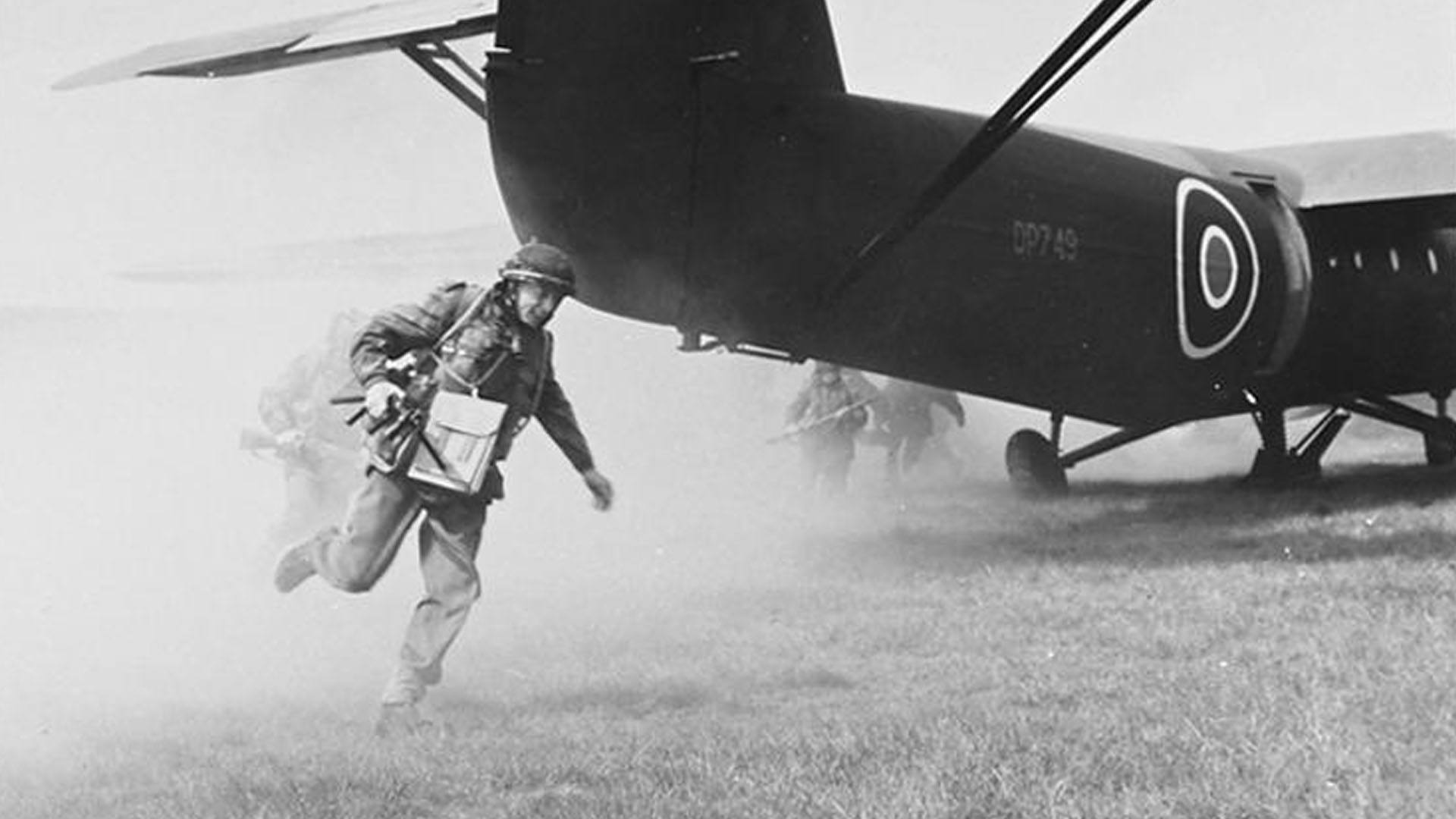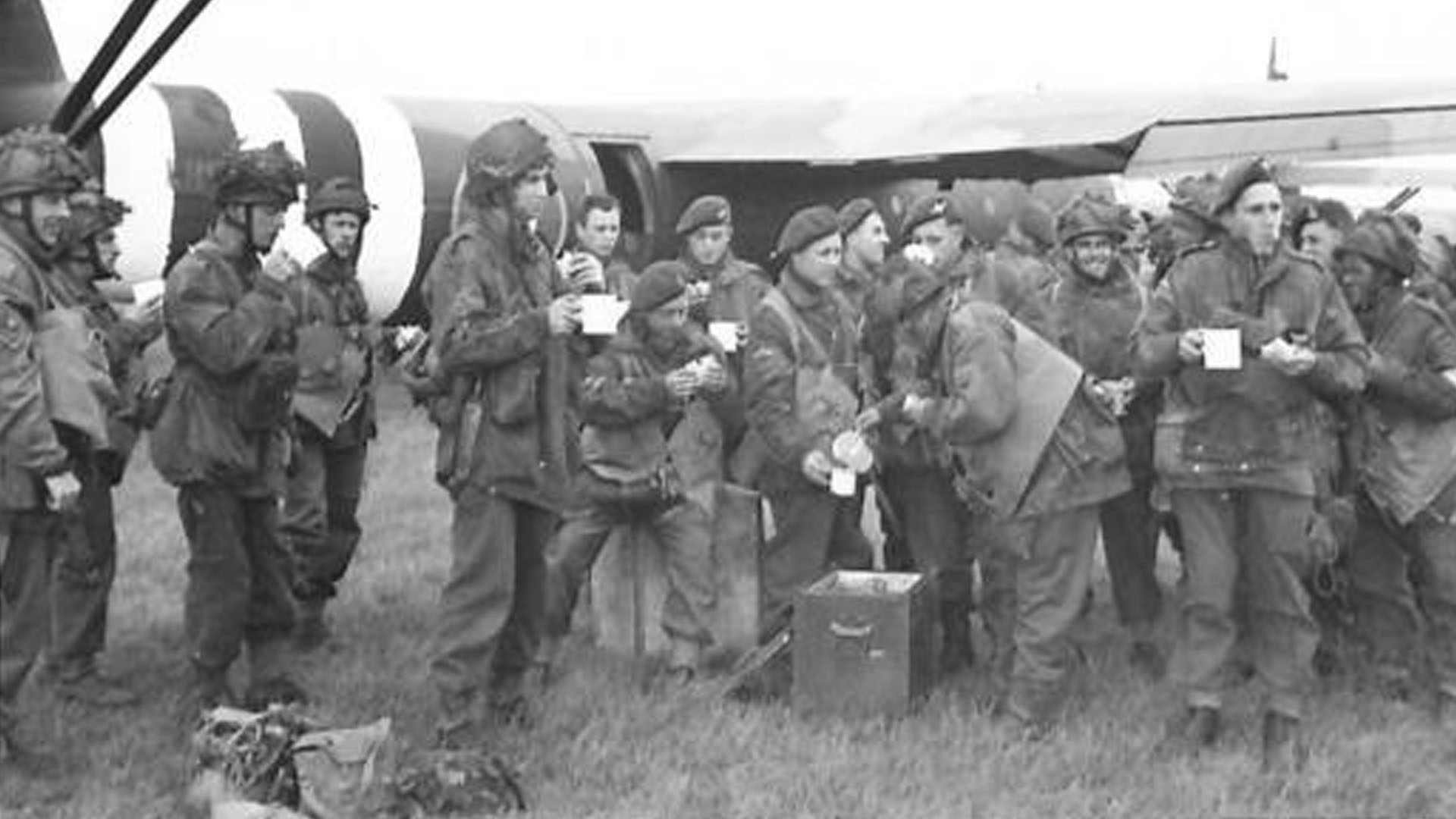On the evening of 6th June 1944, 1st Battalion Royal Ulster Rifles landed in Normandy. Gliders of 6th Airlanding Brigade came down at LZ-N close to the village of Ranville. From there, the Battalion deployed south of the bridgehead and so began a long campaign throughout Normandy.
The Battalion had been in secretive training at transit camps from 25th May 1944. A Company, F Company, and S Company were at RAF Blakehill Farm, Wiltshire. Battalion Headquarters and the other Companies occupied RAF Broadwell, Oxfordshire. Battalion reinforcements remained at Bulford Camp, Wiltshire. Cut off from the outside world, they prepared for the Invasion of Normandy.

Imperial War Museum Photo: (CH 12964) (Part of the Air Ministry Second World War Official Collection). Airborne troops of the British Army's 6th Airlanding Brigade training in the United Kingdom during 1944 in preparation for the Invasion of Normandy. Copyright Royal Air Force Official Photographer.
Pre-Invasion Training
On 1st June 1944, a tragic training accident with a grenade caused the death of Lieutenant Seale and Sergeant Dwyer. Major Warner and several others sustained injuries. Major Rickcord took command of B Company from Warner. Lieutenant Hindon replaced the deceased Seale. There were no further hold-ups in 1st Battalion Royal Ulster Rifles’ plans until 5th June when stormy weather postponed events by 24 hours.

Imperial War Museum Photo: (H 39180) (Part of the War Office Second World War Official Collection). Airborne troops of the British Army's 6th Airlanding Brigade make final preparations and enjoy some food and drink before taking off for Normandy in June 1944. Copyright Captain EG Malindine - War Office Photographer.
The Rifles on D-Day
6th June 1944 was D-Day. Riflemen of 1st Battalion Royal Ulster Rifles departed from their respective airfields. There were no issues with gliders or with the Royal Air Force planes used to tug them across the English Channel. The ride in the gliders was bumpy but uneventful and fighter cover from the Royal Air Force ensured a safe journey towards France. At around 2045hrs, glider-borne troops could make out the coast of France, the River Orne, and the Caen Canal. Light flak burst in the air but made little impact on the gliders. At 2100hrs, the first glider touched down 6 minutes ahead of schedule.
The enemy fired flak and created obstacles in the shape of wooden poles driven into the ground across the Landing Zones. Despite these efforts, 1st Battalion landed smoothly and set about unloading and readying for battle. Unloading of gliders took longer than expected due to difficulties in removing the tail units. Using saws, axes, and other cutting tools, Riflemen removed the wooden tails and, as planned, gathered to the south of Ranville at 2230hrs. Remarkably, the Battalion sustained only a single casualty on D-Day. Rifleman John Woodburn died as a result of mortar fire in the Landing Zone aged 19 years old.

Imperial War Museum Photo: (H 39178) (Part of the War Office Second World War Official Collection). Airborne troops of the British Army's 6th Airlanding Brigade admire their graffiti on the side of their Horsa Glider before taking off for Normandy in June 1944. Copyright Captain EG Malindine - War Office Photographer.
The initial plan for D-Day was to have an advance party including 1st Battalion Second in Command Major J. Drummond arrive on 5th June 1944. He would have received orders before the Battalion landed 24 hours later. His glider unfortunately made a forced landing at Worthing, West Sussex at 0300hrs. He eventually made it to Normandy along with the Battalion on D-Day and has the distinction of being one of the only men to take off for D-Day twice. With plans changed, it was Commanding Officer Lieutenant Colonel R.J.H. Carson who set forth for Brigade Headquarters to receive instruction.
The main of objective of 1st Battalion was to take the village of Sainte-Honorine. Along with high ground at Ring Contour 30 north of Sainte-Honorine, the village was also in enemy hands. Other Companies had secondary objectives. The role of D Company was to take the village of Longueval. Orders came through to The Rifles by 2345hrs and by 0200hrs, C Company under Major F.R.A. Hynds occupied Ring Contour 30. The enemy withdrew to Sainte-Honorine.

Imperial War Museum Photo: (HU 92976) (Part of the Air Ministry Second World War Official Collection). Aerial photo from 800 feet showing some of the Horsa and Hamilcar Gliders of 6th Airlanding Brigade at Landing Zone N near Ranville, Normandy after the D-Day Landings. Copyright Flight Lieutenant Kelly - 106 PR Group.
7th June 1944
Following C Company’s taking of the high ground on 7th June 1944, 1st Battalion Royal Ulster Rifles proceeded as planned. The aim, to take and hold Sainte-Honorine and Longueval. Battalion support came from 1 Field Battery, 1 Light Battery, and from the sea the cruiser HMS Arethusa provided fire support.
C Company and Lieutenant H.R. Morgan’s Medium Machine Gun Platoon would remain on Hill 50. A detachment of C Company with mortars took position on Hill 30. The remaining Battalion mortars established position to the south of Ranville. At 0900hrs, the Battalion’s flanking attack on Longueval would begin with B Company on the right, and A Company and D Company on the left.
Back on Hill 30, C Company was in full view of the enemy based around 1,200 yards away at Sainte-Honorine. Positions occupied under darkness offered little shelter from heavy fire from mortars and self-propelled guns. The Commanding Officer could not reach HMS Arethusa by radio, and the Company sustained many casualties. Meanwhile, A Company, B Company, and D Company took the unoccupied Longueval with ease.
Leaving C Company to provide fire from Hill 30, the Commanding Officer of 1st Battalion Royal Ulster Rifles decided to attack Sainte-Honorine. A Company under Major C.E. Vickery and B Company under Major G.P. Rickcord would launch the attack at 1100hrs. From 15 minutes before the attack, the Battalion would hit the forward edges of the area with mortar fire, before launching an artillery attack. The first stage went according to plan but the infantry assault never followed. There had been insufficient time to mobilise and prepare infantry companies and a new Zero Hour of 1215hrs was set.
There were communication difficulties between Battalion Headquarters and Hill 50. As a result, they only received news of the postponement at 1110hrs and the mortar fire had begun. By 1215hrs, as the infantry advance began, mortars and ammunition were running low. All the while, C Company continued to sustain casualties under heavy enemy fire. From Hill 30, the Company noted 7 enemy 75mm self-propelled guns moving east toward Sainte-Honorine. Believing them to be tanks, a message went to Battalion Headquarters but failed to reach them.
As A Company and B Company advanced on Sainte-Honorine, they came under heavy fire from these guns and other artillery. Despite a valiant attempt, Commanding Officers of the 2 Companies realised the attack could not succeed and fell back to Longueval. C Company also withdrew from the heavily attacked Hill 30, eventually joining the rest of the Battalion at Longueval.
8th June 1944
| Last Name | First Name(s) | Rank | Regiment | Information |
|---|---|---|---|---|
| Allen | Charles | Lance Sergeant | 1st Battalion Royal Ulster Rifles | 7019670 |
| Greer | Henry | Lance Corporal | 1st Battalion Royal Ulster Rifles | 6985178. From Cookstown, Co. Tyrone. |
| Mullins | Patrick James | Rifleman | 1st Battalion Royal Ulster Rifles | 7019652. From Lisburn, Co. Antrim. |
| Payne | Edward Daniel | Rifleman | 1st Battalion Royal Ulster Rifles | 7016562 |
| Raynham | Stewart Rex | Corporal | 1st Battalion Royal Ulster Rifles | 7045517 |
| Starr | Arthur Lionel | Rifleman | 1st Battalion Royal Ulster Rifles | 7021234 |
1st Battalion Royal Ulster Rifles fought through from D-Day on 6th June 1944 until September 1944 as part of the Normandy Campaign.


